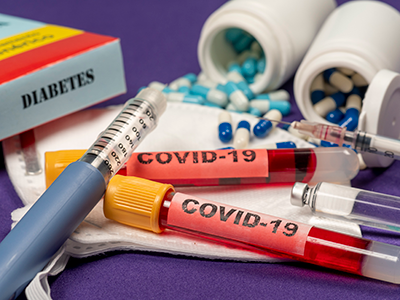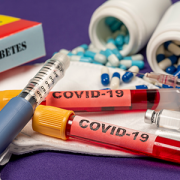Study examines severity of COVID-19 on kids with Type 1 diabetes

A new study published in the Journal of Diabetes, found that although nearly 80% of youth with Type 1 diabetes and COVID-19 infection are managed at home, youth from racial and ethnic minority groups – those with higher hemoglobin A1c values – and those with public insurance are at increased risk for hospitalization.
In a new study published in the Journal of Diabetes, researchers found that although nearly 80% of youth with Type 1 diabetes (T1D) and COVID-19 infection are managed at home, youth from racial and ethnic minority groups – those with higher hemoglobin A1c values – and those with public insurance are at increased risk for hospitalization. Most hospitalizations among these youth were related to diabetic ketoacidosis (DKA) (72%) and 86% of youth hospitalized had an A1c value over 9%. The increased risk for DKA among racial and ethnic minority groups and publicly insured youth in this study is indicative of disparities in T1D outcomes and aligns with other research findings both before and during the pandemic.
Adults with certain underlying medical conditions, like diabetes, are at an increased risk for severe illness from COVID-19. Though there are limited data on youth with T1D who have been infected with COVID-19, viral infections can make it harder to control blood glucose levels. If not properly managed, infections may lead to DKA, a serious life-threatening condition where the body converts fat instead of sugar into energy, causing ketones to build up in the blood and acid levels to rise.
“There is still more to learn about COVID-19 and how it affects children with diabetes and other underlying medical conditions,” said Brynn Marks, M.D., MS-HPEd, pediatric endocrinologist at Children’s National Hospital and one of the study’s co-authors. “We are hopeful that this latest data will emphasize the importance of optimizing glycemic control and give physicians and families more information about the virus and T1D so that severe illness and hospitalizations can possibly be prevented.”
In April 2020, the T1D Exchange Quality Improvement Collaborative, along with endocrinology clinics across the U.S., formed a COVID-19 clinical registry to better understand symptoms and outcomes of patients with T1D who also tested positive for SARS-CoV-2 infection. More than 46 centers nationwide, including Children’s National Hospital, submitted data to this novel registry of 266 youth under the age of 19 with previously established T1D and laboratory confirmed COVID-19.
The study found that nearly 80% of youth with T1D and known COVID-19 infection were cared for at home without any adverse outcomes. It is also important to note that COVID-19 was incidentally discovered in 16% of hospitalized youth admitted for reasons unrelated to COVID-19 or T1D (e.g. urological procedures, psychiatric admissions). However, the data revealed a disproportionate rate of hospitalizations and DKA among racial and ethnic minority groups, children who were publicly insured and those with higher A1c. Out of the 266 patients, 72% of the 61 patients were hospitalized due to DKA. An overwhelming majority (82%) of hospitalized patients had an A1c value greater than 9%. More than 40% of non-Hispanic Black youth in the study were hospitalized as compared to 14% of non-Hispanic white youth. Researchers also noted that those patients with public insurance were less likely to use insulin pumps and continuous glucose monitors, emphasizing the continued need to improve more access to diabetes technologies.
“Diabetes technology has advanced rapidly in the last decade and access to insulin pumps and continuous glucose monitors is improving, however these technological advances are perpetuating pre-existing disparities in T1D care and outcomes,” Dr. Marks said. “The data is clear and there is a pressing need to act to promote optimal care for all people with T1D.”
Recently, Dr. Marks and the Children’s National Diabetes team became official members of the Type 1 Diabetes Exchange Collaborative. The team looks forward to using the opportunity to improve diabetes care both here at Children’s National and across the country.





